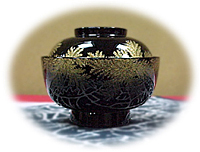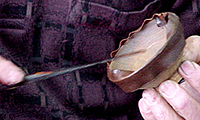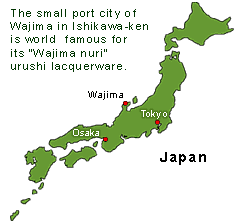|
What is urushi?  Urushi (pronounced "oo-roo-shee") is one of the most durable natural lacquers known to man. Urushi lacquered ornaments including bracelets have been discovered in Japan dating from the Jomon period 9,000 years ago. In the west, these objects are also referred to as "japaned" objects. Hardened urushi is water and acid proof, and also protects the object from heat, salt, mold and mildews and all types of weathering. It has been used on wood, pottery, bone, baskets, fabric and metal. Recently it has been successfully applied to the barrels and caps of fountain pens made of ebonite (black hard rubber) . Urushi (pronounced "oo-roo-shee") is one of the most durable natural lacquers known to man. Urushi lacquered ornaments including bracelets have been discovered in Japan dating from the Jomon period 9,000 years ago. In the west, these objects are also referred to as "japaned" objects. Hardened urushi is water and acid proof, and also protects the object from heat, salt, mold and mildews and all types of weathering. It has been used on wood, pottery, bone, baskets, fabric and metal. Recently it has been successfully applied to the barrels and caps of fountain pens made of ebonite (black hard rubber) .
Urushi is not only a durable varnish but is also one of the strongest adhesives while it is wet, which makes it perfect for decorating with gold powder (maki-e) gold foil (chinkin) or mother of pearl inlays (raden). It is so strong an adhesive that in the distant past urushi was used by hunters and warriors to fix arrowheads to their arrow shafts!
This strength combined with the natural beauty of urushi lacquer ware is the reason it has been so popular for thousands of years.
When we hear of urushi lacquerware, we think of shiny objects such as boxes and bowls covered with gold or colored maki-e decorations. However, the idea of decorating on top of urushi is a relatively new idea. Until the 18th century, urushi lacquer ware was quite plain with no decoration. Red or black urushi was used on a wide variety of objects from household necessities such as rice bowls, sake cups and combs to hunting tools. Swords, shields and entire body armor had coatings of urushi!
Beautiful maki-e "yatate" brush and ink holders produced by Mr. Wakashima of Wakashima Taigado
|
Where does urushi come from?
Urushi lacquer is made from the sap of the urushi tree (Rhus vernicifera). The urushi tree has been considered such a valuable commodity that it was planted all over Japan during the Edo period (1603-1868). However, the areas today where urushi sap is actually produced are very limited.
From June through November the urushi is tapped by slashing the bark of the tree with horizontal cuts to let the thick white sap (arami) ooze from the trunk. This sap begins to solidify as soon as it comes in contact with the air. It is then collected and filtered through absorbent cotton with a centrifugal separator to remove bark and other impurities. The result is raw urushi (nama-urushi) which can be further refined, or used as-is for the base coats in lacquerware. The amount of sap collected from each tree is only around 250 milliliters per year, which makes it a rather precious substance.
The raw urushi is heated at a low temperature and stirred to disperse its ingredients and break down its particles. It gradually turns dark brown in color, and reaches a smooth consistency. It is now ready to be used for the middle and final coats.
What makes urushi so strong?
While most paints dry by the evaporation of some solvent, urushi dries or hardens by absorbing moisture from the air.
The urushi sap contains an oily substance called urushiol. When exposed to warmth and humidity, an enzyme is activated and extracts oxygen from the water and supplies it to the urushiol. The urushiol solidifies, forming a hard film. Even after it has hardened, the urushi retains some water content, making it look perpetually wet and shiny.
Urushiol is the exact same substance found in poison ivy, poison oak, and poison sumac which causes rash and itchiness, so it is not advisable to handle liquid urushi with your bare hands unless you are one of the lucky few who are immune to it. Apparently, Asians and Native Americans are less likely to be sensitive to urushiol.
Urushi lacquerware is often black or red. The black color is produced by adding iron powder, which produces a chemical reaction with the urushiol, turning the urushi to a deep black color. Other colors are produced by adding pigments. Mercuric sulfide produces vermillion, and ferric oxide is used to make red.
 Applying cloth to the edges of the bowl
Applying cloth to the edges of the bowl |
How is urushi lacquerware produced?
Raw urushi is used for base coats, and refined urushi is used for top coats and decoration. The process of producing typical wooden urushi lacquerware has over 20 steps, and more than a hundred individual processes, still done by hand. Even a small object like a bowl can take over 6 months to make.
These steps include:
- seasoning the wood
- carving and sanding it to form the object
- reinforcing fragile parts with linen cloth (for Wajima nuri)
- applying several base coats of raw lacquer
with drying and polishing between each coat
- applying several coats of refeined black or red lacquer
with more drying and polishing between each coat.
Finally, decoration such as maki-e can be applied to the still-wet adhesive urushi, or it can remain in its subtly beautiful undecorated state.
Wajima Nuri  Lacquerware produced in the small port city of Wajima in Ishikawa prefecture has gained worldwide recognition for its beauty and durability. Urushi lacquerware has been produced here since the 16th century, and even now over half of the population of Wajima is involved in its urushi trade. Of all the urushi producing areas in Japan, only the town of Wajima has been officially designated by the government as an "Intangible Cultural Asset" of Japan. Lacquerware produced in the small port city of Wajima in Ishikawa prefecture has gained worldwide recognition for its beauty and durability. Urushi lacquerware has been produced here since the 16th century, and even now over half of the population of Wajima is involved in its urushi trade. Of all the urushi producing areas in Japan, only the town of Wajima has been officially designated by the government as an "Intangible Cultural Asset" of Japan.
Wajima is famous for its own urushi technique called "Wajima nuri." Wajima nuri is different from other types of lacquerware in several ways (including the obvious fact that it is produced in Wajima). One distinction is the use of linen cloth to reinforce fragile parts such as the rim of bowls. The fabric is coated in urushi and then carefully applied to the wood, and smoothed out. After the fabric and urushi has hardened, the whole surface is sanded and coated again and again, so the fabric is no longer distinguishable from the rest of the object. Other distinctions include the type of wood (keyaki), and the application base coatings of a special laquer paste made of urushi and a type of soil called "ji no ko" (powder of the earth). Urushi lacquered fountain pens produced in Wajima do not require the fabric reinforcement or the application of "ji no ko" so they aredescribed as "Wajima urushi nuri" instead of the official designation of "Wajima nuri."
There is also an urushi lacquerware art museum in Wajima, Wajima Shikki-Kaikan filled with lacquer art and items related to the lacquer culture in Japan and Asia established for the promotion and development of urushi lacquer. Seven species of urushi trees can be seen in the museum garden. This is the only museum in Japan devoted to urushi lacquerwork.
Caring for your urushi pen Uurushi is a very tough substance, but it does have a natural enemy. It does not like ultraviolet rays. Prolonged exposure to sunlight will eventually cause it to become dull and lose its durability. In Japan, the most valuable pieces of urushi lacquerware are stored in silk bags or wooden boxes when not in use. So take a little precaution, and don't leave your urushi pens lying around for long periods in direct sunlight. And pass the word onto your children and grandchildren, because with a little care, an urushi pen should outlast the original owner by many generations!
|